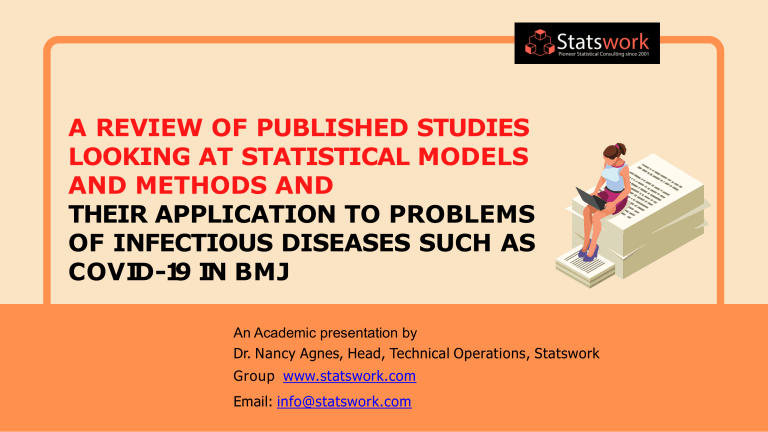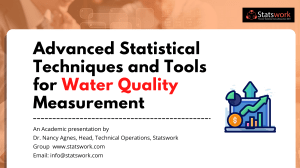A Review of published studies looking at statistical models and methods
advertisement

A REVIEW OF PUBLISHED STUDIES LOOKING AT STATISTICAL MODELS AND METHODS AND THEIR APPLICATION TO PROBLEMS OF INFECTIOUS DISEASES SUCH AS COVID-19 IN BMJ An Academic presentation by Dr. Nancy Agnes, Head, Technical Operations, Statswork Group www.statswork.com Email: info@statswork.com TODAY'S DISCUSSION Outline Introduction Statistical models in human health science Factor analysis Bayesian meta-analysis Models to forecast the risk of covid-19 in the general population Diagnostic models to discover covid-19 in patients with suspected infection Predictive models to diagnose covid-19 Conclusion INTRODUCTION Health science research is the most interesting research area as we identify the pattern of Genomic diseases and various other kinds of diseases. STATISTICAL MODELS IN H U M A N HEALTH SCIENCE The most common statistical approach for any human health studies is correlation and regression analysis. Suppose, consider a vaccine effectiveness study, and the researcher wants to identify the effectiveness of vaccine among the gender or age category. The correlation technique will be useful to identify the relationship between these two variables. Contd... And suppose the researcher wants to predict the effectiveness of future outcomes. In that case, the regression analysis will be useful as it identifies the average linear relationship between the dependent and independent variables. Apart from the usual correlation and regression analysis, many researchers adopt dimensionality reduction techniques such as factor analysis. FACTOR AN ALYSIS Factor analysis reduces the dimensions and creates the latent variables. Each latent variable acts as another variable in the study. With those latent variables, one can construct linear regression analysis and predict future outcomes or simply identify the variables' linear relationship. For example, Goni et al. (2020) considered a Confirmatory factor analysis to study respiratory tract infections in Hajj and Umrah. They collected the data in the form survey involving 72 variables. In practice, analysing the entire 72 variables will yield poor results. Contd... Thus, the dimensionality reduction technique is adopted and measured by the confirmatory factor analysis, which uses the chi-square statistic. Also, Saefi et al. (2020) studied the undergraduate student's knowledge about COVID19, measures taken by them to prevent the disease, and maintaining the health style during COVID19. They conducted a survey and investigated the properties of the KAP questionnaire by adopting Confirmatory Factor Analysis (CFA) and RASCH model and the results of these analyses revealed that each of the items in the questionnaire possesses unique qualities and this questionnaire is adequate enough to measure the student's knowledge, attitude and practice during COVID19. Contd... Further, Siemieniuk et al. (2020) compared the effects of COVID19 treatments from literature using Meta-analysis. Data for this study has been collected daily from different sources such as the WHO website, Centre for Disease Control and Prevention in the U.S., PubMed, etc. The data includes detailed information of the patient affected with COVID19, like the length of stay in ICU, duration of ventilation, etc. BAYESIAN METAANALYSIS With this information, they conducted a Bayesian meta-analysis and performed 10000 Markov Chain iterations using fixed effects and random effects separately and found no statistical incoherence in the analysis. Furthermore, Xu et al. (2020) studied the characteristics of patients affected by COVID19 outside Wuhan in China. The study revealed that people affected with COVID outside Wuhan city are very mild than the people affected in Wuhan. Apart from the viral infectious disease, numerous diseases are of interest to the researchers in finding the causes, remedies, risk factors, etc. Contd... One such increasing research area is cancer studies. Calster et al. (2020) considered a cohort study on ovarian cancer and identified the best model to detect cancer and properly distinguish cancer types. The dataset has been collected from IOTA and selected a proper sample for the analysis. Five different models have been conducted, and the results revealed that SRRisk and ADNEX models performed well in classifying the type of cancer. Healthcare research is to diagnose the disease or find the risk factor associated with the disease. Statistical techniques can be used to analyse the causes of the diseases. Contd... In that sense, Tian et al. (2019) estimated the risk factors of hospital admission related to cardiovascular disease. A total of 184 cities in China are included in the study, and the information related to pollution and hospital admissions are collected. They adopted Time series analysis to investigate the association between pollution and disease. The results showed that short-term exposure to pollution leads to increased hospital admissions for cardiovascular disease. Statswork provides high quality biostatistics services which helps precise estimation of the effect size and increases the generalizability of the results of individual studies. MODELS TO FORECAST THE RISK OF COVID-19 IN THE GENERAL POPULATION They acknowledged seven models that help in predicting the risk of covid-19 in the general population. Three models from one study used hospital admission based on non-tuberculosis pneumonia, influenza, acute bronchitis, or upper respiratory tract infections as substitution outcomes in a dataset without any patients with covid-191. The fourth model uses a deep learning technique detecting thermal video from the faces of people wearing facemasks to detecting abnormal breathing (not covid related) with a reported sensitivity of 80%. Contd... The fifth model uses a mobile application to collect data and to risk-stratify patients. It uses demographics, symptoms, and contact history of users. It further expanded into two more models: blood values and blood values plus computed tomography (C.T.) images. Table: Overview of prediction models for diagnosis and prognosis of covid-1911 DIAGNOSTIC MODELS TO DISCOVER COVID-19 IN PATIENTS WITH SUSPECTED INFECTION It is a type of method or test used to help diagnose a disease or condition. It includes imaging tests and tests to measure blood pressure, pulse, and temperature are examples of diagnostic techniques. Diagnosis has significant implications for patient care, research, and policy. PREDICTIVE MODELS TO DIAGNOSE COVID-19 A predictive model was defined as combining at least two prognostic factors, based on multivariable analysis, as estimating the individual risk of a specific outcome, presented as regression formula, nomogram, or in a simplified form, such as risk score. A predictive model is a formal grouping of multiple predictors from which a particular endpoint's risks can be calculated for individual patients. Other names for a predictive model include prognostic (or prediction) index or rule, risk (or clinical) prediction model, and predictive model. CONCLUSION Further, statistical techniques have been widely used in epidemiological research. Moustgaard et al. (2020) studied the impact of treatment and therapeutically effects in clinical trials using meta-analysis. The results showed no difference in the effects of treatments of patients from the healthcare providers with and without blinding. Furthermore, Fabbri et al. (2020) presented a review on the health care providers and South African patients' funding using meta-analysis. They recommended that the corporate companies provide transparency in providing funds to patients, and this type of funding can be seen in high-income countries. If you are struggling with meta-analysis you can reach our statistical meta-analysis service. Contact Us UNITED KINGDOM +44-1143520021 INDIA +91-4448137070 EMAIL info@statswork.com





